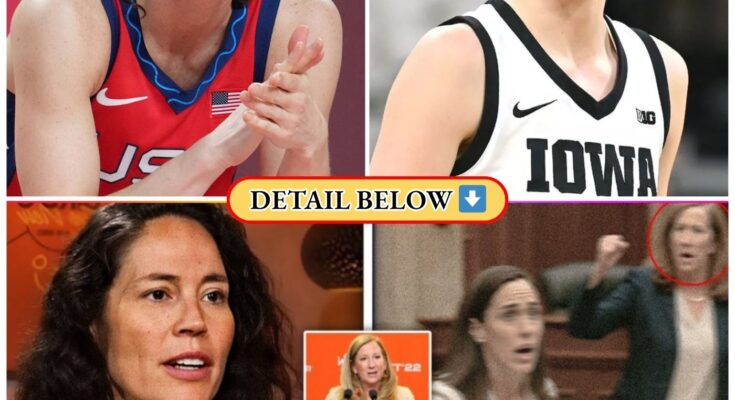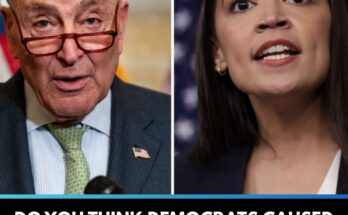What if Caitlin Clark was never supposed to succeed in the WNBA? What if her rise wasn’t only challenged by defenders on the court, but by powerful forces behind the scenes determined to keep her from shining? That reality may not be fiction anymore. The truth is surfacing, and it all begins with WNBA legend Sue Bird.

Sue Bird, a two-time Olympic gold medalist and four-time WNBA champion, holds immense credibility within the league. On June 27th, during her “Bird’s Eye View” podcast, she didn’t just share veteran insights—she dropped what sounded like a bombshell exposé. Instead of praising Clark for her record-setting performances and unprecedented influence on WNBA viewership, Bird pulled back the curtain on the league’s internal strategies. And what she described wasn’t flattering.
According to Bird, internal league memos were distributed that labeled Clark’s passionate supporters as problematic. Broadcasters were reportedly advised to tone down her coverage. Phrases like “limit Caitlin segments,” “focus on league storylines,” and “emphasize balanced coverage over rookie hype” were cited verbatim. To Bird, this was a stark departure from the open celebration she received as a rookie in 2002. But it didn’t stop there.
Bird went on to describe an off-camera meeting where a senior executive allegedly asked, “Can we use the race angle to boost mid-season ratings?” She called it disturbing. This strategy, she explained, wasn’t about promoting basketball or celebrating Clark’s success—it was about manipulating narratives. She drew a contrast to how rookies like Diana Taurasi were embraced without the same restrictions or contrived controversies.

Caitlin Clark told how 2024 WNBA Draft decision should go as Sue Bird makes bold forecast – The Mirror US
This was just the beginning. Fans started noticing something odd on the court as well. On May 18th, during a nationally televised game, Clark lightly slapped the backboard in frustration after missing a three-pointer. She was hit with a technical foul instantly. No warning. No conversation. Just a technical. Compare that to an April 12th incident where Diana Taurasi hurled her warm-up jacket and yelled profanities at a ref and received only a warning. No technical. No suspension.
From there, things escalated. Social media exploded with video montages of questionable non-calls and late whistles involving Clark. One clip showed her getting blindsided on a screen that went uncalled. Two nights later, a similar play involving a veteran led to an immediate flagrant foul. Anonymous referees admitted they had received guidance to enforce stricter rules for rookies. A May 10th memo to referees, reportedly titled “Maintaining Competitive Decorum,” instructed that technical fouls should be used to deter overt displays of frustration from rookies.
By the All-Star break, the evidence had piled up. Every viral clip of Clark’s brilliance was mirrored by one where she seemed singled out by officials. Sports shows picked up the story. Was this officiating bias? Or were referees simply following league orders?
Then came the media firestorm. On June 10th, Commissioner Kathy Engelbert gave an interview to CNBC where she laid out the league’s marketing strategy. She described Clark and fellow rookie Angel Reese as a perfect rivalry—not just because of their playing styles, but because of their racial differences. She said, almost verbatim, that the league saw value in a “white versus Black” narrative. Internally, a document titled “Racial Arc Storyline Outline” was leaked, directing broadcasters to use split-screen visuals and captions like “Ice vs. Grit.”
Outrage erupted within 24 hours. Former NBA players and advocacy groups released a joint letter calling out the league for using identity politics to sell tickets. Clark and Reese, both of whom have dealt with online abuse, released statements denouncing the racial narrative. “We’re athletes first,” Clark said. “Our skin color isn’t the storyline.”
Engelbert’s strategy failed. Not only did it spark backlash, but it also alienated longtime fans. A 12% drop in engagement was recorded from core WNBA audiences. Sponsors like Nike and State Farm privately expressed concern that the league’s narrative choices could harm their brand values.
Things got worse. League spokespeople started blaming “toxic Caitlin Clark fans” whenever hate-filled tweets surfaced. They urged players to stay off social media. Sue Bird and Megan Rapinoe called the tactic lazy and ineffective. “You can’t wish away racism,” Rapinoe said. “You have to confront it.”
And yet, Clark’s supporters kept showing up. Attendance numbers doubled. Ticket sales soared. Kids packed arenas. Merchandise—especially her number 22 jersey—flew off the shelves. Toxic or not, the fan base had spoken: they weren’t going anywhere.
Sue Bird, US women’s basketball seek historic gold medal at Olympics – Sports Illustrated
Behind the scenes, though, the tension was real. A May 2nd internal memo presented two options: embrace Clark as the face of the league, or fall back on traditional drama and rivalries. The document warned against “overexposing” her, fearing backlash from other players. During a May 15th executive meeting, audio was leaked in which one VP said, “We can’t ignore the cash cow,” while another warned, “Clicks from conflict don’t build sustainable fandom.”
This conflict began playing out in real time. Media outlets gave more airtime to technical fouls and off-court narratives than to Clark’s on-court brilliance. Viral clips showcased drama instead of game-winners. The result? A June poll showed that 42% of season ticket holders felt the league was prioritizing controversy over celebration.
Even advertisers began pulling back. Some paused Caitlin-focused campaigns until the WNBA reaffirmed its commitment to authentic storytelling. Internally, the league was in crisis mode.
But now, thanks to Sue Bird, the curtain is lifted. Fans, sponsors, and players are all asking: what kind of league do we want?
Caitlin Clark didn’t just arrive. She exploded onto the scene. She broke records, drew national headlines, and reignited interest in the WNBA. Without her, there is no media boom. No new broadcast deal. No packed arenas.
The WNBA now stands at a crossroads. Will it keep tiptoeing around its biggest star, playing it safe while controversy rages on? Or will it embrace the very force that’s revitalizing it?
The decision won’t just define Caitlin Clark’s legacy. It will shape the future of the entire league.
And one thing’s clear: playing small is no longer an option.

